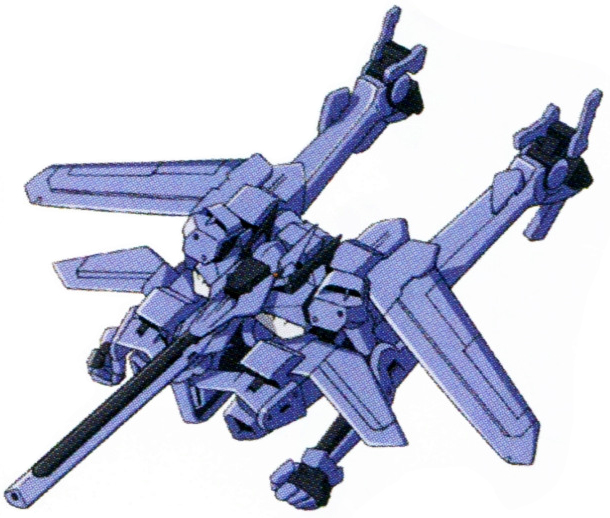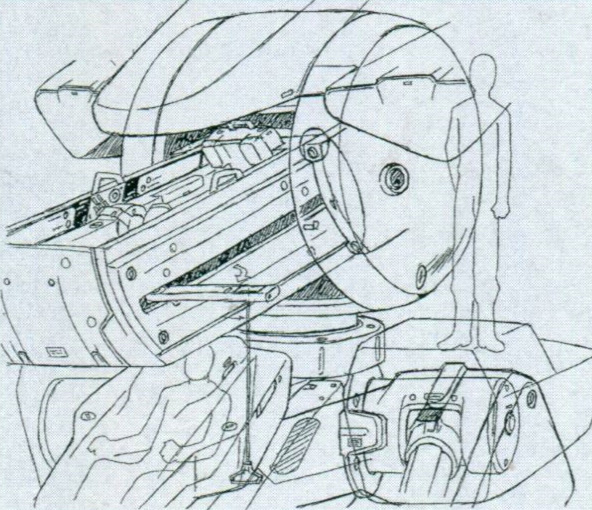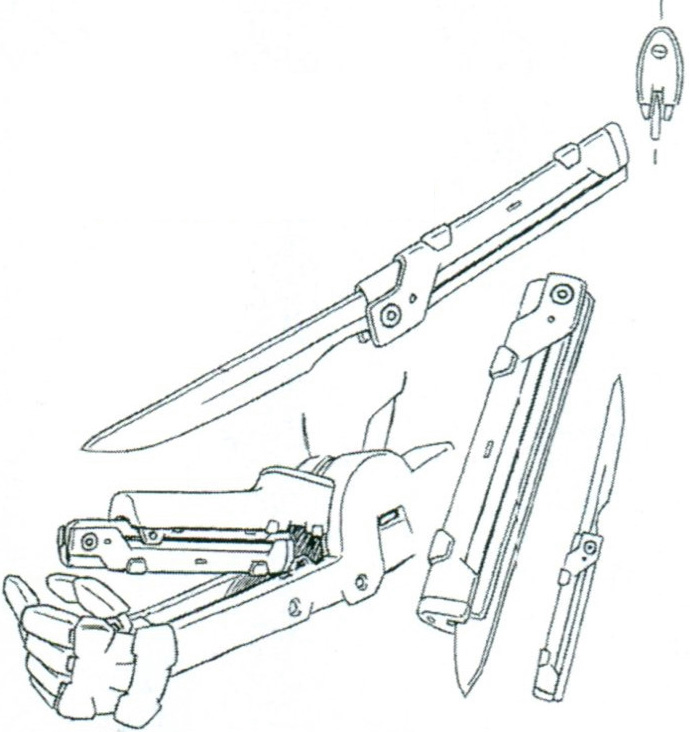Model number: SVMS-01
Code name: Union Flag
Unit type: mass production transformable general purpose mobile suit
Manufacturer: Iris Corporation
Operator(s): Union of Solar Energy and Free Nations; Earth Sphere Federation; Katharon
Rollout: AD 2304 (YMS-01A)
First deployment: AD 2307
Accommodation: pilot only, in standard cockpit in torso
Dimensions: head height 17.9 meters
Weight: max gross 67.1 metric tons
Armor materials: E-Carbon
Powerplant: solar energy system, power output rating unknown
Propulsion: unknown
Equipment and design features: sensors, range unknown
Fixed armaments: 20mm machine gun, mounted on abdomen next to cockpit; defense rod, mounted on left arm; 2 x sonic blade, can generate plasma sword, stored in forearms, hand-carried in use; many x missiles, stored in legs
Optional hand armaments: 120mm linear rifle, mounts as nose in flight mode
The SVMS-01 Union Flag was the Union’s newest mobile suit in 2307 and successor to the aging VMS-15 Union Realdo. Developed by the Iris Corporation, its model number started over at “01” to signify the next generation of transformable mobile suit. Unlike the Realdo, the Flag was capable of transforming on its own without swapping equipment. The Flag’s design was a reflection of the Union’s pretension to be the world’s police. The main intention for the suit’s transformation ability was not so much for travelling within Union territory, but more with allowing it to be deployed across the globe. In flight mode, the Flag could deploy an electromagnetic field from the linear rifle, which allowed the control of the airflow and helped to reduce air resistance. The formation of the electromagnetic field was simply an application of the linear rifle’s capabilities. The Flag’s flight speed was superior to that of even more advanced units like the GN-001 Gundam Exia and GNX-603T GN-X. Sensor devices were embedded in the section of its head that corresponded to the face, and could display specific luminescent patterns. The main camera was located in a gap between the face and the head armor. Four hydrogen plasma jets were used for flight. The hydrogen that served as fuel was infused into the molecular bonds of the carbon that made up the machine’s frame, removing the risk of explosion and eliminating the need for extra space for fuel tanks. The Flag was solar powered and could receive energy from the Union’s orbital elevator. The upper and lower body of the machine could separate, and the lower body has a spare cockpit in the waist section. However, they could not combine while in separated flight.
The Flag’s armaments included a 120mm linear rifle that fired electromagnetically accelerated projectiles. Some degree of charging was required before firing; however, for close combat it could be set to a low-power mode that made rapid fire possible, and in this mode the mechanism could switch to a different type of shell. The rifle’s battery and ammunition were combined into a single pack that was located at the rear section of the rifle. This allowed both to be quickly replaced. A 20mm machine gun was built into the left side of the cockpit drum located in the unit’s abdomen. During flight mode, it was used for missile interception. In mobile suit mode, it was used for anti-personnel/vehicle attacks, etc., that did not require the use of heavy firepower. Despite having low firepower, it was still quite useful due to its high rate of fire. During anti-mobile suit combat, it was mainly used for restricting enemy movements. The sonic blade was made of super-hard carbon and could vibrate at a high frequency to increase cutting power. In addition, it could be used as a plasma sword after focusing plasma around the carbon blade into a sword shape. The length of the plasma blade changed depending on the power output. This weapon was created while developing the beam saber. The plasma blade could last for about three minutes at maximum output.
The spinning motion of the defense rod protected the Flag by deflecting enemy projectiles. It was designed because the suit could not be equipped with a typical heavy shield. In situations where it received attacks from the front, it was possible for the rod to break. As the defense rod was designed for use in mobile suit form, it was not equipped if the suit was launched only for aerial battles. The rod was made from super-hard carbon and could generate a plasma field upon impact with enemy projectile, reducing the impact of the enemy’s attacks. The Flag’s arm storage bay could store other weaponry beside the sonic blade. The suit’s feet contained flare and chaff dispensers in the central round part, which were meant for disrupting laser and infrared guidance. There were also hardpoints on the arms and legs. The shin region of the legs could be used to store missiles, the type of which varied by mission. Although the missiles were mainly used while in flight, they could be used for anti-air fire from the ground by switching the missile type. As the suit could store only limited missiles in its body, missiles pods could be mounted beneath the wings and sub wings, or between the legs. The Union produced multiple variants of the Flag to fit different environments and mission profiles. In 2307, pilot Graham Aker engaged the Gundam Exia in midair combat shortly after the public debut of Celestial Being. Following the formation of the Earth Sphere Federation government, the Flag remained in use with the military, but was also used by organizations like Katharon and even Celestial Being.
Pilot(s): Graham Aker, Howard Mason, Daryl Dodge, Joshua Edwards, Randy, Stuart, Deborah Galiena
First appearance: Mobile Suit Gundam 00
Original mechanical designer: Hitoshi Fukuchi
Gundam 00 Info
Director:
Seiji Mizushima
Writer:
Yousuke Kuroda
Mechanical Designer(s):
Kanetake Ebikawa
Takayuki Yanase
Hitoshi Fukuchi
Kenji Teraoka
Naohiro Washio
Kunio Okawara
Seiichi Nakatani
Character Designer(s):
Yun Kouga
Michinori Chiba
Musical Composer:
Kenji Kawai
Format:
50 episodes; 3 compilation movies
Airdates:
Japan 10.06.2007 – 03.29.2008 (S1);
10.05.2008 – 03.29.2009 (S2)
U.S. 11.24.2008 – 02.09.2009 (S1);
06.29.2009 – 09.21.2009 (S2)
Video Release (SE):
Japan 10.27.2009 – 02.23.2010
U.S. 09.04.2018











Comments